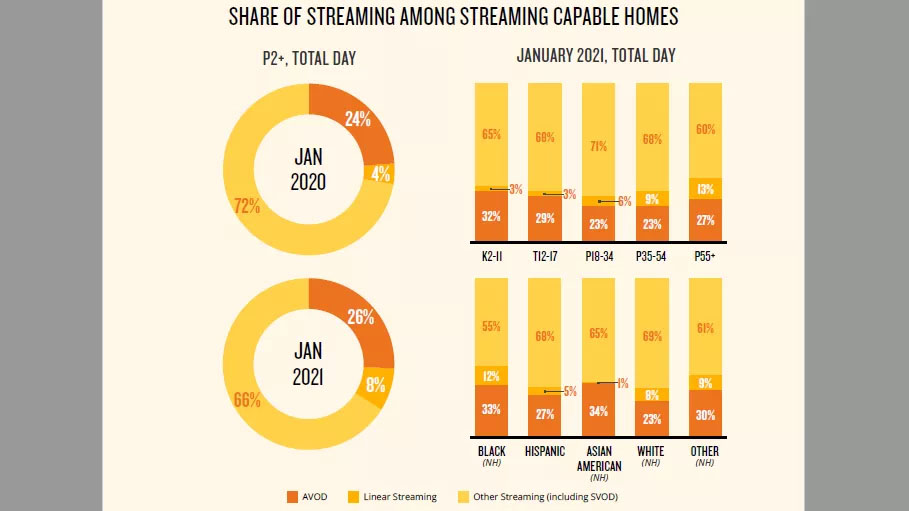(Image credit: Nielsen)
By
Source: www.nexttv.com, March 2021
A year of living with COVID resulted in a drop in advertising spending, but streaming added viewership and created a new avenue for markers to reach consumers, Nielsen said in its new Total Audience Report.
In 2020, ad spending in major media fell 15% to $132 billion. TV spending shrunk, but its share of ad dollars increased to 68% from 64%.
Also Read: Time Spent Watching Video Fell in Third Quarter: Nielsen
The pandemic had the largest impact in the second quarter, when advertising spending dropped 28% from the previous year Spending was down 25% in the third quarter and only decreased 5% in the fourth quarter. Some categories rebounded, including online retail and insurance, which were up in the fourth quarter from a year ago. Travel, financial, traditional retail and automotive were still down by double digits.
While most of the headlines were about the growth of ad-free SVOD services like Netflix and Disney Plus, Nielsen found that ad supported streaming accounted for 34% of all streaming in January of 2021, compared to 28% in January 2020.
But marketers were even able to find a way to reach consumers on commercial-free services via product placement and branded content. Among viewers 35 to 49, 68% said they noticed specific products or brands being used by the characters within the content on a streaming video service.
The marketing messages had a positive impact with 42% of 35 to 49 year olds saying they were very likely or somewhat likely to be influenced or to purchase a brand they see within streaming content. Only 17% said the were somewhat unlikely or very unlikely.
During the pandemic TV commercials referring to the pandemic aired as companies adjusted their marketing and their messaging. In the second quarter, 18% of commercials dealt with COVID. That fell to 12% in the third quarter and 11% in the fourth quarter.
Consumers also reacted to COVID by shopping at local businesses, the Nielsen survey found.
Things may be getting back to something closer to normal for consumers as well. According to a special advertising survey Nielsen did in February, 55% of people said they are very optimistic or optimistic that they could get back to their normal routine in 2021. Adult men were more optimistic than women, according to the survey.
People were particularly looking forward to attending religious services in person, going to hair salons, barber shops and nail salons, booking vacations and dining out within three months of COVID restrictions being lifted.
Most postponed put off making major purchases during the pandemic. Nielsen’s survey found that 40% of adults said they planned to purchase or lease a new or used car in the next 12 months and 20% said they intend to buy a house in the next year.
“With many people still spending more time at home, the TV remains a media diet mainstay and key opportunity for advertisers to present in a visual medium. 2020 was a year of widespread streaming adoption, which has fueled an array of new services and platforms—both subscription and ad-supported,” said Peter Katsingris, senior VP, audience insights at Nielsen.
“But that doesn’t mean brands can’t tap into subscription platforms, as we’re seeing growing interest in branded integrations in programming that isn’t ad supported, and some of those integrations are driving key storylines,” Katsingris added.

